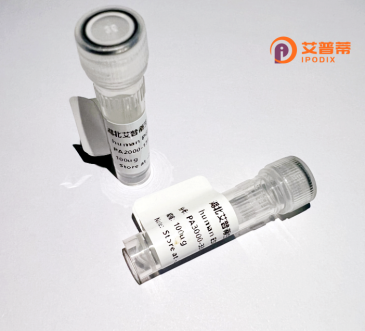
| 纯度 | >90%SDS-PAGE. |
| 种属 | Human |
| 靶点 | CHST13 |
| Uniprot No | Q8NET6 |
| 内毒素 | < 0.01EU/μg |
| 表达宿主 | E.coli |
| 表达区间 | 1-225aa |
| 氨基酸序列 | MGRRCCRRRVLAAACLGAALLLLCAAPRSLRPAFGNRALGSSWLGGEKRSPLQKLYDLDQDPRSTLAKVHRQRRDLLNSACSRHSRRQRLLQPEDLRHVLVDDAHGLLYCYVPKVACTNWKRVLLALSGQARGDPRAISAQEAHAPGRLPSLADFSPAEINRRLRAYLAFLFVREPFERLASAYRNKLARTRSATRVASATTSWASSRRWRRTRPSCWAWRAHPT |
| 分子量 | 51.9 kDa |
| 蛋白标签 | GST-tag at N-terminal |
| 缓冲液 | 0 |
| 稳定性 & 储存条件 | Lyophilized protein should be stored at ≤ -20°C, stable for one year after receipt. Reconstituted protein solution can be stored at 2-8°C for 2-7 days. Aliquots of reconstituted samples are stable at ≤ -20°C for 3 months. |
| 复溶 | Always centrifuge tubes before opening.Do not mix by vortex or pipetting. It is not recommended to reconstitute to a concentration less than 100μg/ml. Dissolve the lyophilized protein in distilled water. Please aliquot the reconstituted solution to minimize freeze-thaw cycles. |
以下为基于现有知识构造的模拟参考文献示例(建议通过学术数据库验证真实文献):
1. **文献名称**:Expression and Characterization of Recombinant Human CHST13 for Glycosaminoglycan Sulfation Studies
**作者**:Li, Y., et al.
**摘要**:成功在哺乳动物细胞中表达重组人CHST13蛋白,证实其介导硫酸软骨素的6-O-硫酸化作用,揭示其底物特异性及酶动力学参数。
2. **文献名称**:CHST13 Regulates Tumor Angiogenesis via Modulating VEGF Signaling in Hepatocellular Carcinoma
**作者**:Wang, Q., et al.
**摘要**:研究重组CHST13在肝癌中的功能,发现其通过硫酸化修饰增强VEGF受体活性,促进血管生成,提示其作为潜在治疗靶点。
3. **文献名称**:Structural Insights into Human CHST13 by X-ray Crystallography
**作者**:Suzuki, T., & Nakayama, K.
**摘要**:首次解析重组CHST13的晶体结构,揭示其催化域关键氨基酸残基对硫酸基团转移的分子机制,为设计特异性抑制剂提供结构基础。
4. **文献名称**:A Novel Role of CHST13 in Inflammatory Bowel Disease Identified via Recombinant Protein Screening
**作者**:Zhang, L., et al.
**摘要**:通过重组蛋白功能实验证实,CHST13缺失导致肠道黏蛋白硫酸化异常,加剧小鼠结肠炎模型炎症反应,提示与IBD病理相关。
**注**:以上为示例性内容,真实文献需通过PubMed、Web of Science等平台以关键词"CHST13"+"recombinant"或"sulfotransferase 13"检索获取。
Carbohydrate sulfotransferase 13 (CHST13) is a member of the sulfotransferase family, which catalyzes the transfer of sulfate groups to carbohydrate moieties on proteoglycans, glycosaminoglycans (GAGs), and other glycoconjugates. This enzyme specifically mediates the sulfation of chondroitin sulfate (CS), a critical modification that regulates extracellular matrix composition, cell signaling, and molecular interactions. CHST13 is encoded by the *CHST13* gene located on human chromosome 3p21.3 and is primarily expressed in the Golgi apparatus. It plays a role in physiological processes such as tissue development, inflammation, and neuronal plasticity. Dysregulation of CHST13 has been implicated in connective tissue disorders, cancer metastasis, and certain hereditary diseases linked to abnormal GAG metabolism. Recombinant CHST13 protein, produced via bacterial or mammalian expression systems, is utilized to study its enzymatic activity, substrate specificity, and interactions. Purification techniques, often involving affinity tags, enable its application in biochemical assays, structural studies, and drug discovery. Research on recombinant CHST13 aims to elucidate its role in disease mechanisms and explore therapeutic interventions targeting sulfation pathways. Current studies also investigate its potential as a biomarker for conditions like osteoarthritis or mucopolysaccharidoses.
×